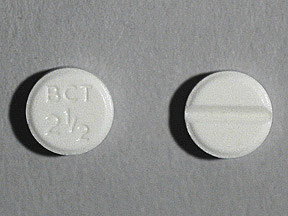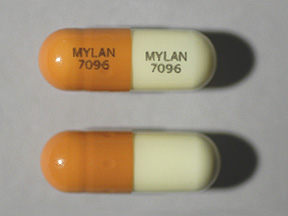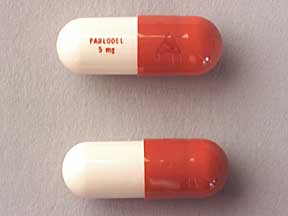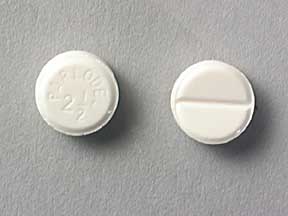-
bromocriptine generic
bromocriptine: Adult Dosing
Dosage forms: 2.5,5acromegaly
- 20-30 mg PO qd
- Start: 1.25-2.5 mg PO qhs x3 days, incr. 1.25-2.5 mg/day q3-7 days; Max: 100 mg/day; Info: give w/ food
hyperprolactinemia
- 2.5-15 mg PO qd
- Start: 1.25-2.5 mg PO qd, incr. 2.5 mg/day q2-7 days; Info: give w/ food
Parkinson's dz
- 10-30 mg PO tid
- Start: 1.25 mg PO bid, incr. 2.5 mg/day q2-4wk; Max: 100 mg/day; Info: give w/ food
*neuroleptic malignant syndrome
- 5-10 mg PO tid-qid
- Start: 2.5 mg PO tid-qid, incr. as tolerated; Max: 20 mg PO qid; Info: continue x7-10 days, then taper dose over 3 days
renal dosing
- not defined
- renal impairment: caution advised
hepatic dosing
- not defined
- hepatic impairment: caution advised
bromocriptine: Peds Dosing
Dosage forms: 2.5,5adenoma, prolactin-secreting
- 11-15 yo
- Dose: 2.5-10 mg PO qd; Start: 1.25-2.5 mg PO qd, incr. q2-7 days; Info: give w/ food
- >16 yo
- Dose: 2.5-15 mg PO qd; Start: 1.25-2.5 mg PO qd, incr. 2.5 mg/day q2-7 days; Info: give w/ food
renal dosing
- not defined
- renal impairment: caution advised
hepatic dosing
- not defined
- hepatic impairment: caution advised
bromocriptine: Contraindications/Cautions
- hypersens. to drug/class/compon.
- hypersens. to ergot derivatives
- HTN, uncontrolled
- pregnancy (hyperprolactinemia pts)
- breastfeeding
- caution if impaired renal fxn
- caution if impaired liver fxn
- caution if cardiovascular dz
- caution if MI hx w/ arrhythmia
- caution if antihypertensive use
- caution if PUD/GI bleed hx
- caution if psychosis
- caution if dementia
- caution in pregnancy
- caution in post-partum w/ cardiovascular dz hx
- caution in elderly pts
- caution if long-term use (>2y)
bromocriptine: Drug Interactions
Avoid/Use Alternative
Monitor/Modify Tx
Therapeutic Advantage
Caution Advised
bromocriptine: Adverse Reactions
Serious Reactions
- seizures
- stroke
- hallucinations
- syncope
- hypotension, severe
- MI
- arrhythmias
- HTN
- Raynaud's phenomenon (rare)
- pleural effusion (rare)
- pericardial effusion (rare)
- pulmonary fibrosis (rare)
- retroperitoneal fibrosis (rare)
- constrictive pericarditis (rare)
- GI bleed
- neuroleptic malignant syndrome (rare)
Common Reactions
- nausea
- headache
- dizziness
- drowsiness
- fatigue
- lightheadedness
- nasal congestion
- abdominal pain
- diarrhea
- constipation
- hypotension, orthostatic
- anorexia
- dyspepsia
- involuntary movements
- visual disturbances
- digital vasospasm
- vomiting
- ataxia
- elevated ALT, AST
- elevated alk phos
bromocriptine: Safety Monitoring
-
Pregnancy:
B, see Contraind/Caut.
- Lactation:
Unsafe
- Avoid Pregnancy:
use contraceptive method other than oral contraceptives if large adenoma present or until normal menses restored
- Monitoring Parameters:
pregnancy test at least q4wk during amenorrhea, then after menses
restored if menstrual periods >3 days late; BUN/Cr, CBC w/ diff,
LFTs, cardiovascular eval. if chronic tx; visual fields if
macroprolactinoma; BP, especially during tx start
bromocriptine: Pharmacology
- Metabolism: liver; CYP450: 3A4 substrate
- Excretion: bile 95%, urine 2.5-5.5%; Half-life: biphasic 4-4.5h, 15h
- Class:
Other Endocrine/Metab., Anti-Parkinsonians
- Mechanism Of Action
stimulates dopamine receptors, inhibits anterior pituitary prolactin secretion (dopamine agonist)bromocriptine: Manufacturer/Pricing
- Manufacturer:
generic
- DEA/FDA: Rx
Approximate Retail Price
- tablet:
- 2.5 mg (30 ea): $61.99
bromocriptine: Patient Education
- Generic Name: bromocriptine
- Pronounced: broe moe CRIP teen
- Brand Name: Parlodel
What is the most important information I should know about bromocriptine?
Bromocriptine may cause low blood pressure, which can lead to dizziness and other symptoms, especially when you rise from a sitting or lying position. Rise slowly and use caution until you know how this medicine affects you. Also use caution when driving or performing other hazardous activities.
If you are taking bromocriptine to treat high prolactin levels caused by a tumor, notify your doctor if you experience persistent, watery, nasal discharge.
What is bromocriptine?
Bromocriptine lowers prolactin (PRO lak tin) levels. Prolactin is a hormone important for the production of breast milk and for normal fertility in women. Bromocriptine also has effects similar to a chemical called dopamine (DOE pa meen) that occurs naturally in the body.
Bromocriptine is used to treat disorders such as amenorrhea (lack of a menstrual period), persistent breast milk production, infertility, and other conditions associated with high prolactin levels caused by prolactin-secreting tumors in women and in men.
In addition, bromocriptine reduces growth hormone levels. This is useful in treating acromegaly, a condition that involves excessive growth.
Bromocriptine is also used to treat Parkinson's disease, which is associated with low levels of dopamine in the brain. Bromocriptine has effects similar to those of dopamine, which makes it effective in the treatment of the stiffness, tremors, spasms, and poor muscle control associated with Parkinson's disease.
Bromocriptine may also be used for purposes other than those listed in this medication guide.
What should I discuss with my healthcare provider before taking bromocriptine?
Before taking bromocriptine, tell your doctor if you
- have heart disease,
- have had a heart attack in the past, or
- have any other serious illness.
You may not be able to take bromocriptine, or you may require a lower dose or special monitoring during treatment if you have any of the conditions listed above.
Bromocriptine is in the FDA pregnancy category B. This means that it is unlikely to be harmful to an unborn baby. Do not take bromocriptine without first talking to your doctor if you are pregnant or could become pregnant during treatment.
Bromocriptine prevents the production of breast milk. Do not take this medication without first talking to your doctor if you are breast-feeding a baby.
How should I take bromocriptine?
Take bromocriptine exactly as directed by your doctor. If you do not understand these directions, ask your pharmacist, nurse, or doctor to explain them to you.
Take each dose with a full glass of water.
Take bromocriptine with food.
Continue to take this medication unless your doctor recommends that you stop. It may be some time before you see the benefits of bromocriptine.
It is important to take bromocriptine regularly to get the most benefit.
Your doctor may want you to have blood tests or other medical evaluations during treatment with bromocriptine to monitor progress and side effects.
Store bromocriptine at room temperature away from moisture and heat.
What happens if I miss a dose?
Take the missed dose as soon as you remember. However, if it is almost time for the next dose, skip the missed dose and only take the next regularly scheduled dose. Do not take a double dose of this medication.
What happens if I overdose?
Seek emergency medical attention if an overdose is suspected.
Symptoms of a bromocriptine overdose include nausea, vomiting, constipation, sweating, pale skin, dizziness, drowsiness, yawning, confusion, and hallucinations.
What should I avoid while taking bromocriptine?
Bromocriptine may cause low blood pressure, which can lead to dizziness and other symptoms, especially when you rise from a sitting or lying position. Rise slowly and use caution until you know how this medicine affects you. Also use caution when driving or performing other hazardous activities.
What are the possible side effects of bromocriptine?
Stop taking bromocriptine and seek emergency medical attention if you experience an allergic reaction (difficulty breathing; closing of the throat; swelling of the lips, tongue, or face; or hives).
If you are taking bromocriptine to treat high prolactin levels caused by a tumor, notify your doctor if you experience persistent, watery, nasal discharge.
Other, less serious side effects may be more likely to occur. Continue to take bromocriptine and talk to your doctor if you experience
- mild nausea, vomiting, or abdominal cramps;
- diarrhea or constipation;
- headache, dizziness (especially when rising from a sitting or lying position), or drowsiness;
- dry mouth; or
- nasal stuffiness.
Side effects other than those listed here may also occur. Talk to your doctor about any side effect that is unusual or bothersome.
What other drugs will affect bromocriptine?
Before taking bromocriptine, tell your doctor if you are taking any of the following medicines:
- erythromycin (Ery-Tab, E.E.S., E-Mycin, others);
- phenylpropanolamine (a decongestant used in many over-the-counter cough, cold, allergy, and diet medications);
- albuterol (Proventil, Ventolin, Volmax); or
- terbutaline (Brethine, Bricanyl).
The medicines listed above may increase the effects of bromocriptine and lead to dangerous side effects.
The effects of bromocriptine may be decreased by phenothiazines such as chlorpromazine (Thorazine), thioridazine (Mellaril), mesoridazine (Serentil), perphenazine (Trilafon), and fluphenazine (Prolixin). Tell your doctor if you are taking a phenothiazine. A larger dose of bromocriptine may be necessary.
Drugs other than those listed here may also interact with bromocriptine. Talk to your doctor and pharmacist before taking any prescription or over-the-counter medicines, including vitamins, minerals, and herbal products.
Where can I get more information?
Your pharmacist has more information about bromocriptine written for health professionals that you may read.
What does my medication look like?
Bromocriptine is available with a prescription under the brand name Parlodel. Other brand or generic formulations may also be available. Ask your pharmacist any questions you have about this medication, especially if it is new to you.
- Parlodel 2.5 mg--white, round, scored tablets
- Parlodel 5 mg--caramel and white capsules
Remember, keep this and all other medicines out of the reach of children, never share your medicines with others, and use this medication only for the indication prescribed.
Every effort has been made to ensure that the information provided by Cerner Multum, Inc. ('Multum') is accurate, up-to-date, and complete, but no guarantee is made to that effect. Drug information contained herein may be time sensitive. Multum information has been compiled for use by healthcare practitioners and consumers in the United States and therefore Multum does not warrant that uses outside of the United States are appropriate, unless specifically indicated otherwise.
Multum's drug information does not endorse drugs, diagnose patients or recommend therapy. Multum's drug information is an informational resource designed to assist licensed healthcare practitioners in caring for their patients and/or to serve consumers viewing this service as a supplement to, and not a substitute for, the expertise, skill, knowledge and judgment of healthcare practitioners. The absence of a warning for a given drug or drug combination in no way should be construed to indicate that the drug or drug combination is safe, effective or appropriate for any given patient. Multum does not assume any responsibility for any aspect of healthcare administered with the aid of information Multum provides.
The information contained herein is not intended to cover all possible uses, directions, precautions, warnings, drug interactions, allergic reactions, or adverse effects. If you have questions about the drugs you are taking, check with your doctor, nurse or pharmacist.
bromocriptine: Pill Pictures
 bromocriptine (generic) 2.5 mg
bromocriptine (generic) 2.5 mg
 bromocriptine (generic) 2.5 mg
bromocriptine (generic) 2.5 mg
 bromocriptine (generic) 5 mg
bromocriptine (generic) 5 mg
 Parlodel (bromocriptine) 5 mg
Parlodel (bromocriptine) 5 mg
 Parlodel (bromocriptine) 2.5 mg
Parlodel (bromocriptine) 2.5 mg
CONDITIONS OF USE: The information in this database is intended to supplement, not substitute for, the expertise and judgment of your healthcare professional. The information is not intended to cover all possible uses, directions, precautions, drug interactions or adverse effects, nor should it be construed to indicate that use of a particular drug is safe, appropriate or effective for you. You should consult your healthcare professional before taking any drug, changing your diet or commencing or discontinuing any course of treatment.
Substantial effort has been made to ensure that the information provided by Rx Drug News is accurate and up-to-date, but this information is not intended to cover all possible uses, precautions, or other considerations relating to the therapies covered.
Rx Drug News does not advocate or endorse the use of any drug or other therapy and does not diagnose patients.
Healthcare professionals should use their professional judgment in using this information, and this information should not be considered a substitute for the care and professional judgment provided by a licensed healthcare practitioner.
This information if provided on an "as is" basis, and Rx Drug News and its affiliates, agents and licensors assume no responsibility for any aspect of healthcare administered with the aid of this information or any other use of the information.
Copyright 1996-2006 Cerner Multum, Inc. Version: 5.05. Revision Date: 10/09/2007
Last Updated: 10/09/2007
Subscribe to the "News" RSS Feed 
TOP ۞
